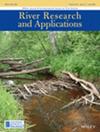溪流修复对本地切喉鳟栖息地和数量的影响
IF 1.9
4区 环境科学与生态学
Q4 ENVIRONMENTAL SCIENCES
引用次数: 0
摘要
修复工作者每年花费超过 10 亿美元修复美国的河流和溪流,但用于评估项目成效的资源却相对较少。与此同时,监测和传播恢复项目的成果仍然是我们从过去的成功和失败中吸取经验教训并最终提高恢复成本效益的最佳机会。我们对落基山脉的一个溪流修复项目的物理和生物成果进行了监测,该项目的目标是改善本地科罗拉多河切喉鳟(CRCT)的栖息地并提高其产量,其范围包括采用不同修复处理方法的三个连续河段。此外,我们还评估了修复项目在实现其既定目标方面的效果。为了检验修复工程对物理和生物指标的影响,我们将 "修复前后、控制影响(BACI)"研究设计与(广义)线性混合模型相结合。在 7 年的时间里,我们发现洪泛区连通性、河岸稳定性和河岸灌木覆盖率都得到了恢复性提高,夏季溪流温度也有所下降。尽管测得本地鳟鱼栖息地有所改善,但我们没有发现恢复对 1 岁及以上 CRCT 的密度或生物量有任何影响。尽管我们的研究范围有限,但我们的研究结果为河流修复的监测和有效性方面相对较少的工作做出了贡献。本文章由计算机程序翻译,如有差异,请以英文原文为准。
Stream Restoration Effects on Habitat and Abundance of Native Cutthroat Trout
Restoration practitioners spend more than $1 billion each year restoring US rivers and streams but commit comparatively few resources to evaluating project effectiveness. Meanwhile, monitoring and disseminating the outcomes of restoration projects remains our best opportunity to learn from past successes and failures and to, ultimately, improve the cost effectiveness of restoration. We monitored the physical and biological outcomes of a stream restoration project in the Rocky Mountains, the goals of which were to improve habitat for and productivity of native Colorado River Cutthroat Trout (CRCT) and the scope of which included three contiguous reaches under different restoration treatments. Moreover, we evaluated the efficacy of the restoration project relative to its stated goals and objectives. To test for restoration effects on physical and biological indicators we coupled a before‐after, control‐impact (BACI) study design with (generalized) linear mixed models. Over the course of 7 years, we detected restoration‐related increases in floodplain connectivity, streambank stability, and riparian shrub cover, as well as decreases in summer stream temperature. Despite measured improvements in native trout habitat, we detected no evidence of a restoration effect on density or biomass of age‐1 and older CRCT. Although our study was somewhat limited in scope, our findings contribute toward a relatively small body of work on monitoring and effectiveness of river restoration.
求助全文
通过发布文献求助,成功后即可免费获取论文全文。
去求助
来源期刊

River Research and Applications
环境科学-环境科学
CiteScore
4.60
自引率
9.10%
发文量
158
审稿时长
6 months
期刊介绍:
River Research and Applications , previously published as Regulated Rivers: Research and Management (1987-2001), is an international journal dedicated to the promotion of basic and applied scientific research on rivers. The journal publishes original scientific and technical papers on biological, ecological, geomorphological, hydrological, engineering and geographical aspects related to rivers in both the developed and developing world. Papers showing how basic studies and new science can be of use in applied problems associated with river management, regulation and restoration are encouraged as is interdisciplinary research concerned directly or indirectly with river management problems.
 求助内容:
求助内容: 应助结果提醒方式:
应助结果提醒方式:


